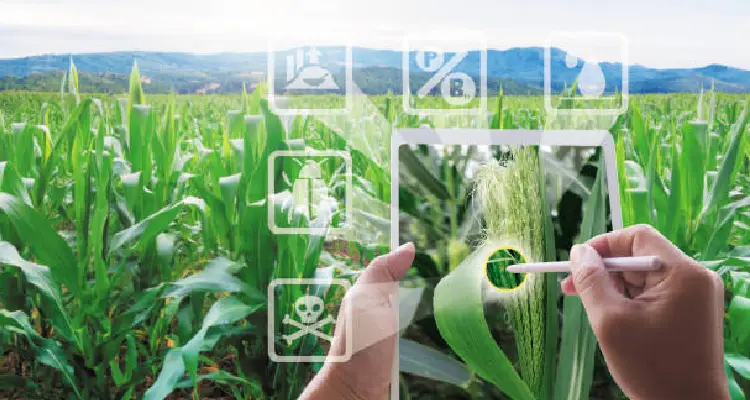Technology plays a pivotal role in revolutionizing traditional agriculture practices by enhancing efficiency, productivity, and sustainability. Image recognition in agriculture is a groundbreaking innovation transforming how we cultivate and manage crops. This cutting-edge technology is reshaping how farmers approach crop management, bringing efficiency, precision, and sustainability to the forefront.

Image recognition is a game-changer for farmers worldwide that involves advanced algorithms and artificial intelligence software to analyze and interpret visual data captured through images. This technology holds immense potential in agriculture to revolutionize various aspects of crop management, from monitoring plant health to automating labor-intensive tasks.
As we delve into an era of smart agriculture, image recognition is a beacon of innovation, guiding farmers toward sustainable and efficient practices. Monitoring crops with precision, detecting issues early, and accurately predicting yields empowers farmers to make informed decisions that enhance productivity and contribute to environmental conservation.
This technology involves the analysis of visual data captured by drones, satellites, or on-site cameras to provide real-time insights into crop health, pest infestations, and overall field conditions.
Facilitate Your Agriculture Business’s Digital Evolution With Image Recognition Tool
Leverage the potential of game-changing tools like image recognition in the agriculture industry and our extensive digital offerings to transform your farming business.
Applications Of Image Recognition In Agriculture
Crop Monitoring
Image recognition enables crop health monitoring by analyzing images of fields captured by drones or other devices. It can detect early signs of diseases, nutrient deficiencies, or pest infestations, allowing farmers to take prompt and targeted corrective measures.
Early Pest Detection
Image recognition helps in the early detection of pests and diseases by analyzing subtle changes in crop color, texture, and growth patterns. This proactive approach allows farmers to implement targeted interventions, reducing the need for broad-spectrum pesticides and minimizing environmental impact.
Weed Management
Weeds compete with crops for resources and can significantly impact yields. Image recognition technology helps identify and differentiate between crops and weeds, facilitating precision weed control. This reduces the reliance on herbicides and minimizes environmental impact.
Yield Prediction
Accurate yield prediction is crucial for efficient resource allocation and market planning. Image recognition technologies can accurately assess crop development stages and predict yields when integrated with data analytics. This empowers farmers to optimize harvesting schedules and streamline distribution processes.
Precision Agriculture
By analyzing images of fields over time, image recognition contributes to precision agriculture. It helps farmers make data-driven decisions regarding irrigation, fertilization, and crop protection. Additionally, it aids in precision yield based on real-time data, optimizing harvest planning.
Livestock Monitoring
Image recognition is not limited to crops but also livestock monitoring. By analyzing images or videos, farmers can track the health and behavior of animals, identify signs of distress or illness, and enhance overall management practices.
Farming Tasks Automation
Image recognition technology and robotics integration can automate various farming tasks, such as fruit picking or sorting. This reduces labor costs and increases efficiency and accuracy in handling agricultural processes.
Implementing Image Recognition: A Practical Approach
Data Collection
The first step in implementing image recognition in agriculture is the collection of relevant data. This involves capturing high-quality images of the fields using drones or other imaging devices. The more diverse and comprehensive the dataset, the better the model’s ability to recognize patterns.
Machine Learning Models
Machine learning algorithms lie at the heart of image recognition. These models are trained on large datasets to identify patterns, allowing them to make accurate predictions. Farmers can choose or develop models tailored to their specific crops and environmental conditions.
Farm Management Integration
Image recognition is integrated into existing farm management systems for seamless adoption. This ensures that farmers can easily access and interpret the insights generated by the technology, making informed decisions in real-time.
Perks Of Implementing Image Recognition In Agriculture
Increased Efficiency
Automation and real-time monitoring lead to increased operational efficiency. Farmers can respond promptly to issues identified through image recognition, optimizing resource use, and reducing waste.
Precision Farming
Precision agriculture, made possible by image recognition, allows farmers to apply inputs with greater precision. This results in resource savings, improved crop yields, and minimized environmental impact.
Cost Reduction
Image recognition in agriculture reduces overall costs by automating tasks and minimizing resource use. This is particularly significant in areas such as labor, herbicides, and fertilizers.
Sustainable Agriculture Practices
Image recognition supports sustainable farming practices by promoting precision agriculture, reducing the environmental impact of farming operations, and optimizing the use of natural resources.
Data-Driven Decision-Making
The wealth of data generated through image recognition provides farmers with valuable insights. Informed decision-making becomes a reality, empowering farmers to implement strategies that positively impact productivity and sustainability.
Make Crop Control Better In Agriculture With AI-Powered Image Recognition.
The Future Of Agriculture: Sustainable & Smart Trends
As we stand at the intersection of agriculture and technology, image recognition emerges as a powerful tool driving the industry toward greater efficiency, sustainability, and productivity. The integration of this technology not only transforms traditional farming methods but paves the way for a more resilient and innovative agricultural future. By harnessing image recognition capabilities, farmers can navigate the complexities of modern agriculture with precision, ensuring a plentiful harvest and a sustainable future for generations to come.
As we embrace image recognition in agriculture, we pave the way for a more sustainable future. Precision farming, made possible by the nuanced insights of image recognition, minimizes resource wastage. Farmers can optimize irrigation, fertilization, and pesticide application, reducing environmental impact. By embracing this technology, we move towards a more eco-friendly agricultural landscape.
While image recognition in agriculture has shown immense promise, it has challenges. Issues such as data privacy, algorithm accuracy, and accessibility to technology need careful consideration. Looking forward, ongoing advancements in machine learning, increased affordability of technology, and collaborative research efforts are expected to address these challenges and further enhance the capabilities of image recognition in agriculture.
How RisingMax Offers The Best Image Recognition Solutions For The Agriculture Industry
By combining a deep understanding of agriculture, technological innovation, and a commitment to user-centric solutions, RisingMax Inc., a prominent AI development company, positions itself to deliver cutting-edge image recognition solutions tailored to the unique needs of the agriculture industry.
Understand Agriculture Specifics
We conduct in-depth research to understand the unique challenges and requirements of the agriculture industry. Our team collaborates with agronomists and agricultural experts to gain insights into the specific needs of farmers and the nuances of different crops.
Crops & Regions Customization
We develop image recognition models that can be customized for different types of crops and variations in regional agricultural practices. Also, we consider factors like varying soil conditions, climate, and crop diseases that may impact the effectiveness of the solution.
IoT Devices Integration
We help businesses explore integration with IoT devices like sensors and drones to enhance data collection capabilities. Our team enables seamless communication between image recognition systems and these devices to create a comprehensive, real-time monitoring ecosystem.
User-Friendly Interfaces
Our dedicated team designs user-friendly interfaces for farmers and agronomists to easily interact with the image recognition system. We implement intuitive dashboards and mobile applications that provide actionable insights in a clear and understandable manner.
Machine Learning Model Training
We conduct continuous machine learning model training using diverse datasets to improve accuracy and adapt to evolving agricultural conditions. We provide tools for farmers to easily update and fine-tune models based on their specific needs and observations.
Collaboration & Feedback Loop
We establish a collaborative approach by seeking feedback from farmers, agronomists, and industry experts. Our team implements feedback loops to continuously improve the system based on real-world usage and changing agricultural dynamics.
To Briefly Conclude
The fusion of image recognition with evolving technologies presents exciting prospects. Sensors with advanced capabilities and seamless integration with IoT devices could usher in an era where farms operate as interconnected smart systems. Artificial intelligence algorithms are poised to evolve, enabling even more sophisticated decision-making processes and further enhancing the efficiency and productivity of agricultural practices.
In conclusion, image recognition in agriculture is a transformative force, ushering in a new era of precision, sustainability, and productivity. As technology advances, the integration of artificial intelligence and agriculture promises a future where farmers can navigate the complexities of crop management with unprecedented insight and efficiency.












